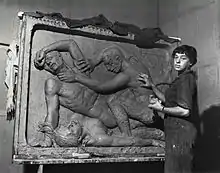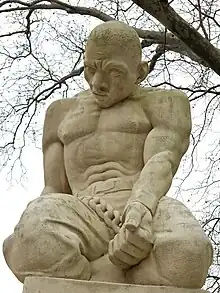Hélène Sardeau
Hélène Sardeau (July 7, 1899 – March 23, 1969) was an American sculptor, born in Antwerp, Belgium, who moved with her family to the United States when she was about 14 years old.[1]
Hélène Sardeau | |
|---|---|
 Hélène Sardeau, mid to late 1930s | |
| Born | July 7, 1899 Antwerp, Belgium |
| Died | March 23, 1969 (aged 79) Croton-on-Hudson, NY, U.S. |
| Nationality | American |
| Known for | Sculpture |
| Movement | American modernism |
| Spouse | |
Early years
Sardeau arrived in the United States in 1913.[1] She studied at Barnard College, the Art Students League of New York, Cooper Union, and at the School of American Sculpture, all in New York City.[2][1] She studied with Mahonri Young.[3] In the 1920s, she and he sister, Mathilde, created decorative portrait dolls depicting actors and actresses.[4][5] She is credited with the masks for the 1927 film Prometheus in Chains.[6]
Career
She was a founding member of the Sculptors Guild. Her first major commission was The Slave (1940), completed as part of the Central Terrace of the Ellen Phillips Samuel Memorial in Philadelphia[3] and exhibited at the Museum of Modern Art before its permanent installation.[7] Her terra cotta sculpture, The Lovers (1937), was included in the Museum of Modern Art's Three Centuries of American Modernism (May 24–July 31, 1938), an exhibition that also traveled to the Musée du Jeu de Paume in Paris.[8] In 1942, Brazil's Minister of Education commissioned Sardeau and her husband, George Biddle, for sculptural reliefs and mural paintings, respectively, at the National Library in Rio de Janeiro, for which Sardeau sculpted on the themes of violence and compassion.[9] In the summer of 1949, she was one of 254 sculptors who exhibited in the 3rd Sculpture International held at the Philadelphia Museum of Art.[10] In Life magazine's photograph of the International, she is pictured in the second row from the front, fourth from the left.[10]
Personal life
Sardeau was the wife of painter George Biddle.[11][12] They had a son named Michael John.[1]
Her papers can be found in the Smithsonian Institution's Archives of American Art.[13]
Work

- In many private collections and:[14]
- Amazon, Pennsylvania Academy of the Fine Arts, Philadelphia (1932)
- Mother and Child, Whitney Museum of American Art, New York City (1933)
- Sailors of the United States Mails (full-scale model, Ossining, NY Post Office), plaster with metal armature and hemp, Smithsonian American Art Museum, Washington, D.C. (1936)[15]
- The Slave, limestone, Ellen Phillips Samuel Memorial, Fairmount Park, Philadelphia (1940)[16]
- Negro Lament, Philadelphia Museum of Art (1941)
- Planting, Mother and Child, Reaping, post office reliefs, metal, Greenfield, MA (ca. 1941)[17]
- Reliefs for the National Library of Brazil, soapstone, Rio de Janeiro, Brazil (1942)[9][18]
- Icarus, plaster and bronze (1951)[19]
- Kneeling Woman, bronze, Metropolitan Museum of Art, New York City (1955)[20]
- Rape of the Sabine, Corcoran Gallery of Art, Washington, D.C.
- Untitled, relief print, woodcut, University of Maryland Art Gallery, College Park, MD (n.d.)[21]
References
- "HELENE SARDEALI, SCULPTOR, DEAD; Wife of George Biddle Had Work in Many Museums". The New York Times. Retrieved March 28, 2018.
- Opitz, Glenn B, Editor, Mantle Fielding's Dictionary of American Painters, Sculptors & Engravers, Apollo Book, Poughkeepsie NY, 1986 p.811
- "Helene Sardeau". Smithsonian American Art Museum. Retrieved March 28, 2018.
- Cavendish, Charles (May 1922). "Players See Themselves as Dolls". Theatre Magazine. 35: 302–303.
- "PORTRAIT DOLLS HAVE MADE THEIR DEBUT IN SOCIETY; Introduced by Miss Helene Sardeau, Their Patron Saint -- Miniature Copies of Human Beings Combine the Art of Sculptor, Painter and Modiste". The New York Times. June 15, 1924. ISSN 0362-4331. Retrieved March 28, 2018.
- MacKinnon, Kenneth (October 8, 2013). Greek Tragedy into Film. Routledge. ISBN 9781317806868.
- Elisofon, Edward Alden Jewelleliot (June 25, 1940). "Exhibitions of Art to Aid War Relief; 'the Slave' Goes on Exhibition Here". The New York Times. ISSN 0362-4331. Retrieved March 28, 2018.
- "Three Centuries of American Art | MoMA". The Museum of Modern Art. Retrieved March 28, 2018.
- "Art Notes". The New York Times. Retrieved March 28, 2018.
- "70 Sculptors 70". Life. Vol. 26. June 20, 1949. pp. 112–113.
- Biddle, George, An American Artist's Story, Little, Brown and Company, Boston, 1939 pp.250-251, a book Biddle dedicated to Sardeau
- Opitz, p. 811
- Art, Archives of American. "Summary of the Helene Sardeau papers, [ca. 1920-1950] - Archives of American Art, Smithsonian Institution".
- "SIRIS - Smithsonian Institution Research Information System".
- "Sailors of the United States Mails (full-scale model, Ossining, NY Post Office)". Smithsonian American Art Museum. Retrieved March 28, 2018.
- "The Slave - Association for Public Art". Association for Public Art. Retrieved March 28, 2018.
- "Post Office Reliefs - Greenfield MA - Living New Deal". Living New Deal. Retrieved March 28, 2018.
- obituary dated "3-27-69"
- Nyenhuis, Jacob E. (2003). Myth and the Creative Process: Michael Ayrton and the Myth of Daedalus, the Maze Maker. Wayne State University Press. ISBN 0814330029.
- Gardner, Albert TenEyck; N.Y.), Metropolitan Museum of Art New York (1965). American Sculpture: A Catalogue of the Collection of the Metropolitan Museum of Art. Metropolitan Museum of Art.
- "Untitled | University of Maryland Art Gallery". www.artgallery.umd.edu. Retrieved March 28, 2018.